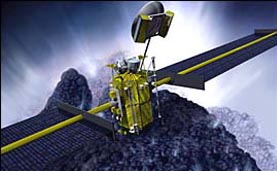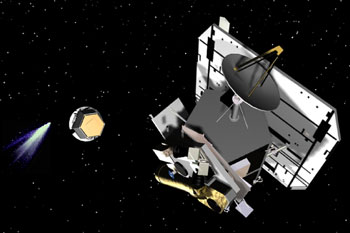Click on image for full size
Courtesy of NASA
Related links:
Comet Probe Mission is Scrapped
News story originally written on June 30, 1999
A mission that would have sent a probe to comet Tempel 1 has been postponed indefinitely. This mission, the first of it's kind, would have landed on the comet in 2005. Unfortunately, other projects have used up the money allotted towards the program. This is the first time a mission has been scratched in 10 years.
"What we're trying to do is solve our own problems," said Edward Weiler, head of NASA's space science program. "Nobody is coming to our rescue from somewhere else in the government."
NASA says it was just bad luck for the mission, called the Space Technology 4/Champollion project. Of all the missions planned by NASA, this one was in the earliest stages. NASA had only spent $10 million on the project. For comparison, the next earliest mission was Mars Surveyor '01, which has already soaked up $100 million.
NASA spent the majority of the $240 million set aside for the comet probe on the Hubble Telescope and the new Chandra-X Space Telescope. The Chandra-X project recently used an extra $60 million on sudden development problems. The gyroscopes aboard Hubble need repairs, which has forced NASA to send up a crew to fix it. The money left over will be given to other missions in various stages of development.
"We know very, very little about how comets are formed and what their constituency is," says Brian Muirhead, who led the successful Mars Pathfinder mission in 1997 and also managed Space Technology 4. "If you're serious about planetary protection, you have to know more about comets than we do today."















